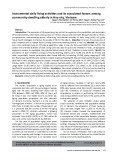
63
Journal of Medicine and Pharmacy, Volume 11, No.07/2021
Instrumental daily living activities and its associated factors among
community-dwelling elderly in Hue city, Vietnam
Nguyen Phuong Mai1, Vo Thi Hue Man2, Nguyen Hoang Thuy Linh1*
(1) Hue University of Medicine and Pharmacy, Hue University, Vietnam
(2) Tokyo Medical and Dental University, Japan
Abstract
Introduction: The extension of life expectancy has led to the expansion of comorbidities and declination
of functional ability, which have consequences on mental, physical and social well-being of the elderly. Hence,
comprehensive understanding factors influencing instrumental activities of daily living (IADL) will guide
future health strategies to improve the quality of life for the elderly. Objective: To access the prevalence of
IADL limitation and its related factors among community-dwelling elderly in Hue city. Method: We carried
out a cross-sectional study on 427 elderly aged 60 or older in Hue city from April 2020 to March 2021. The
Lawton Instrumental Activities of Daily Living scale was used to access the limitation of IADL. Using logistics
regression analysis to investigate the potential determinants of IADL limitation in older adults. Result: The
prevalence of IADL limitation among community-dwelling elderly were 51.0% and 40.7% for female and
male, respectively. Female participants often found difficulty in traveling (41.2%), going shopping (37.6%)
and food preparing (33.5%) and problems related to going shopping (38.5%) and traveling (18.1%) were most
observed in male. Logistics regression analysis revealed that advanced age (aOR = 8.57, 95% CI: 4.20 – 17.48),
illiteracy (aOR = 5.54, 95% CI: 1.79 – 17.20), physical inactivity (aOR = 2.67, 95% CI: 1.67 – 4.56), walking aid
usage (aOR = 27.06, 95% CI: 3.15 – 232.89) and visual impairment (aOR = 2.31, 95% CI: 1.36 – 3.93) as being
significantly associated with IADL limitation. Conclusion: The overall prevalence of the community-dwelling
elderly who reported limitation in performing IADL was considerably high. Healthcare programs should focus
on early health status screening and developing healthy lifestyle campaigns for the elderly.
Keyword: instrumental activities of daily living, IADL, community-dwelling elderly, Hue city
1. BACKGROUND
The world’s population is aging rapidly at an
unprecedented rate, with the percentage of people
aged over 60 years doubling from about 11% to
22% between 2000 and 2050, 80% of them will
be living in low- and middle-income countries [1].
Aging population projections are also observed
in Vietnam. Currently, Vietnam is in the so-called
“demographic window”, in which the proportion of
labor force is double the number of dependents, yet
it is predicted that the country will enter the aging
period in 2040 [2]. Vietnam witnessed a growing
proportion in the aging population, which had
increased from 6.96% (1979) to 11.78% within 40
years and will be reaching 26.1% by 2049 [3].
The fast pace of population aging poses great
challenges to the provision of social welfare services
that the healthcare systems are unable to address the
soaring demand of older people, even in high-income
countries [4]. The elderly is vulnerable to a decline
in physical capacity and changes in neuromuscular
since functional impairment is an inevitable result
of aging process. Notably, in Vietnam, nearly 40%
elderly suffered from comorbidity [5] or more than
80% older people rated their health moderate and
poor [6]. Conditions of functional limitation and
dependence on others in performing instrumental
daily living activities could worsen the quality of life
among older people.
The presence of IADL limitation varied widely
across countries, timeframe and population settings
[7]. In Vietnam, the prevalence of those having at
least one IADL ranged from 11.92% to 43.3% [8],
[9]. Previous studies showed the development of
functional decline was complex, multifactorial and
a consequence of the interactions between physical,
social and environmental factors. Determinants of IADL
limitation are heterogeneous and vary cross different
settings. Knowing the fact that some potential factors
may influence functioning of IADL is crucial for effective
interventions and health promotion.
For all reasons mentioned, this study aimed to
explore the limitation of IADL and its related factors
among community-dwelling elderly.
Corresponding author: Nguyen Hoang Thuy Linh; email: nhtlinh@huemed-univ.edu.vn
Received: 9/8/2021; Accepted: 15/10/2021; Published: 30/12/2021
DOI: 10.34071/jmp.2021.7.8





















